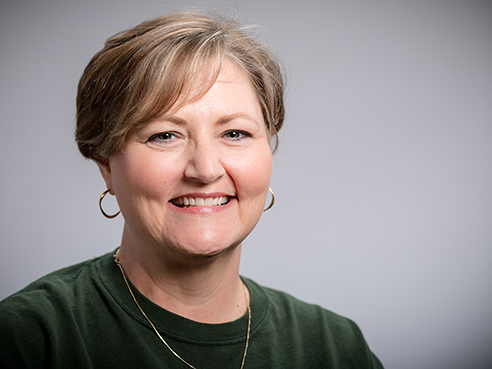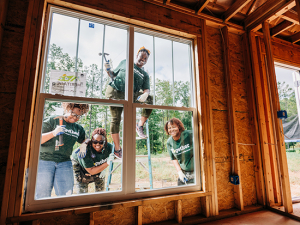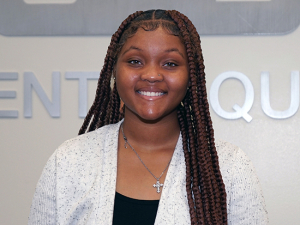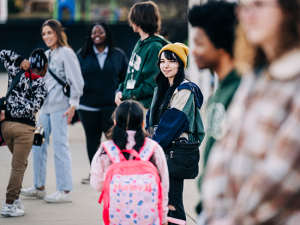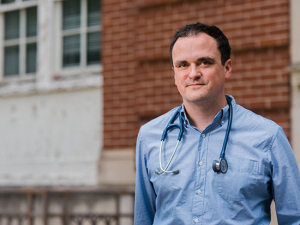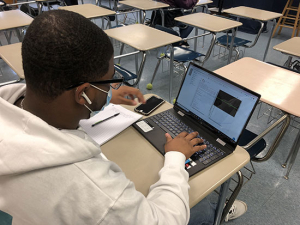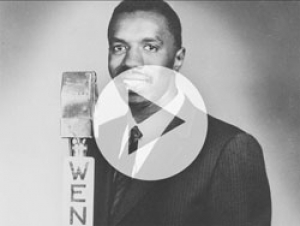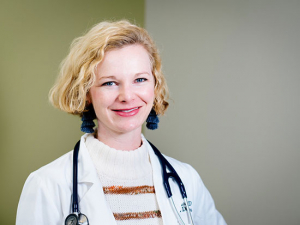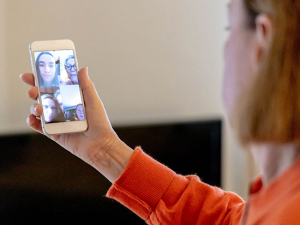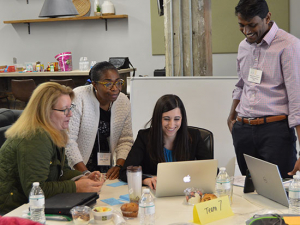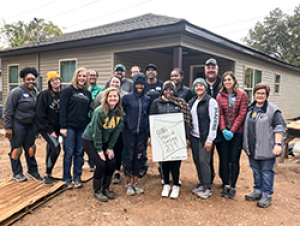 Lourdes Sánchez-López, Ph.D., professor of Spanish in the Department of Foreign Languages and Literatures; Robin Lanzi, Ph.D., professor in the Department of Health Behavior in the School of Public Health; and Jenelle Hodges, instructional design specialist in the School of EducationAs part of the university’s commitment to community engagement as outlined in its strategic plan, Forging the Future, the online platform BlazerPulse was implemented in January as a new way to organize, promote and measure engagement and scholarship on campus and in the community. And in nearly seven months, Blazers have completed more than 36,500 hours of community service — all tracked in BlazerPulse.
Lourdes Sánchez-López, Ph.D., professor of Spanish in the Department of Foreign Languages and Literatures; Robin Lanzi, Ph.D., professor in the Department of Health Behavior in the School of Public Health; and Jenelle Hodges, instructional design specialist in the School of EducationAs part of the university’s commitment to community engagement as outlined in its strategic plan, Forging the Future, the online platform BlazerPulse was implemented in January as a new way to organize, promote and measure engagement and scholarship on campus and in the community. And in nearly seven months, Blazers have completed more than 36,500 hours of community service — all tracked in BlazerPulse.
The platform is continuing to grow as users take advantage of new opportunities — including the first cohort of service-learing courses piloted in BlazerPulse during the spring semester.
UAB is using feedback from faculty such as Lourdes Sánchez-López, Ph.D., professor of Spanish in the Department of Foreign Languages and Literatures; Robin Lanzi, Ph.D., professor in the Department of Health Behavior in the School of Public Health; and Jenelle Hodges, Ph.D., instructional design specialist in the School of Education, each of whom used BlazerPulse to track their students’ community engagement throughout the spring semester.
An easier process
Service-learning and engaged scholarship have long been a priority in UAB’s curriculum, no matter the subject. For years, Sánchez-López has been teaching Foreign Languages and Literatures 333, a service-learning internship course in which students have community-based opportunities to use Spanish or French and apply intercultural competence in professional contexts. Sánchez-López, who was a member of the community-engagement task force that helped bring BlazerPulse to UAB, matches students with community partners that align with their professional goals, and each student must spend a minimum three hours per week with them.
Though Sánchez-López has years of experience teaching FL 333, she says accurately and easily tracking student service hours always proved frustrating. During the spring semester, students in FL 333 piloted BlazerPulse as a tracking tool for those hours, and community partners such as the Cahaba Valley Health Care and AIDS Alabama’s Alabama Latino AIDS Coalition, used the platform to verify that record. Students also wrote reflection papers in Canvas.
“I had more automatic and frequent contact with the community partners weekly. It was more personal and direct.” |
Using BlazerPulse had many positive outcomes, Sánchez-López says, including an enhanced partnership with community organizations.
“I had more automatic and frequent contact with the community partners weekly — it was more personal and direct,” Sánchez-López said. “We were part of a three-way team: the community partner, me as a faculty member and the student.”
Sánchez-López says she plans to continue using BlazerPulse in future service-learning courses. While she admits it may take a while for other faculty and community partners to get the hang of tracking their hours on the platform, it only has positive potential.
“It’s going to be very good for us to make stronger connections because it will allow easier flow from UAB out into the community and from the community into UAB,” she said.
Learning the ropes
“It’s just like using your iPhone. There’s a lot you can do with it, but until it becomes something you know how to use, you aren’t tapping into everything it can do.” |
Lanzi offered a brand-new honors seminar, HC 212, on mental health promotion, where students explored opportunities to raise awareness about mental health conditions, reduce the stigma around it and understand from a public health perspective how mental health affects various populations. Students partnered with the Crisis Center Inc. in Birmingham to gain experience in the field. They participated in the Crisis Center’s various programs, including their talk and crisis lines, then formed teams to design a mental health promotion campaign, whether it was an educational program or a new intervention or policy.
Each student logged their activity with the Crisis Center in BlazerPulse, in addition to supplemental class-wise activities such as service-learning days at One Roof and other associated mental health promotion activities.
Using BlazerPulse was helpful for tracking how and where her students were engaging with the community, says Lanzi, who is also director of academic programs in the department. She added that the support she received from the Office of Service Learning and Undergraduate Research was crucial. Geren Dunn, an AmeriCorps VISTA from the Office of Service Learning and Undergraduate Research, visited her class twice during the semester to provide training and feedback on using BlazerPulse.
Lanzi says she wants to continue using BlazerPulse as it grows and changes and encourages UAB to continue trying to simplify the platform and provide more trainings both one-on-one and in group venues such as faculty meetings.
“It’s just like using your iPhone,” Lanzi said. “There’s a lot you can do with it, but until it becomes something you know how to use, you may not necessarily be tapping into everything it can do. It will take more iterations [of BlazerPulse], time and support, just like in Canvas and the other platforms we use.”
Real-world applications
Hodges uses online service-learning in IDD 610, part of UAB’s fully online master’s program in instructional design and development, which trains qualified instructional designers to analyze, design, develop, evaluate and implement quality online, blended and on-ground instruction. In IDD 610, students work with clients to analyze knowledge gaps and design instruction and learning opportunities to help them close that gap.
Students in IDD 610 tracked their hours spent working with each client in BlazerPulse; the purpose, Hodges says, was to ensure classwork was being accomplished and also help students understand that not every project will come with an easy solution.
“We have a great university, and this gives us a great way to tell our stories — seeing all the different ways the university as a family is helping our community.” |
“For our purposes, the time tracked wasn’t important as the time spent accomplishing the objective,” Hodges said. “Tracking hours helped them understand that not everything is a quick fix and realize there is a real-world application and perspective for their learning.”
Because her students had never used BlazerPulse before, Hodges wasn’t sure whether they went back to see just how much time had been invested with each client, but that might change as their familiarity grows. Continuing to use BlazerPulse is important for faculty, she adds, because it tracks how UAB makes an impact on our community, local and nationally.
“It’s not just for service-learning courses, but for all the different volunteer opportunities that faculty find themselves participating in,” Hodges said. “We have a great university, and this gives us a great way to tell our stories — seeing all the different ways the university as a family is helping our community.”
Moving forward
The Office of Service Learning and Undergraduate Research gathered feedback from Sánchez-López, Lanzi, Hodges and other pilot faculty and passed it along to GivePulse, the parent company that developed the BlazerPulse platform. Additionally, the office has designated one of its AmeriCorps VISTAs, Geren Dunn, to become an expert on all things BlazerPulse and provide more training and support. Those interested in learning more about using the platform can email Dunn at ggdunn@uab.edu.
To schedule a BlazerPulse training session, email Geren Dunn at ggdunn@uab.edu. |
Attend a BlazerPulse training session with Dunn 10-11:30 a.m. Aug. 27 or 29 in Education Building 243 to learn everything from basic user functions to class customizations and other advanced administrator functions. Register for the sessions on BlazerPulse.
All faculty teaching service-learning courses this fall have the option to use BlazerPulse, and their experiences and feedback will be used to continue streamlining and optimizing the platform. All designated service-learning courses have been added to BlazerPulse by Information Technology, so that faculty interested in using its organizational, tracking and measurement features can begin exploring the platform before the fall semester begins. To request your course be designated as service-learning, complete the online form.
“We are excited about the future of BlazerPulse and how it will facilitate increased community engagement of UAB students, faculty and staff,” said Amy Badham, director for the Office of Undergraduate Research and Service Learning. “It’s valuable feedback from faculty and other stakeholders using the platform that will help us to optimize the platform making it more user-friendly and effective.”
